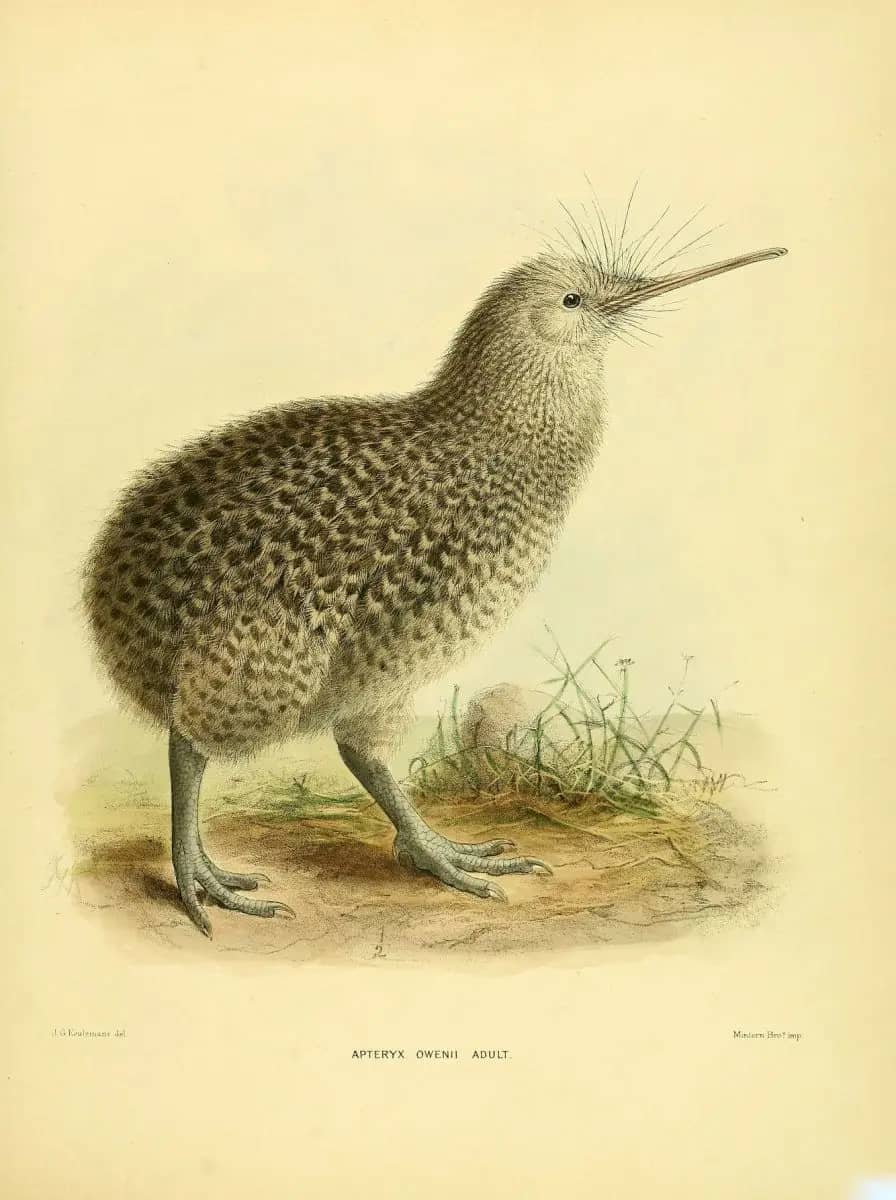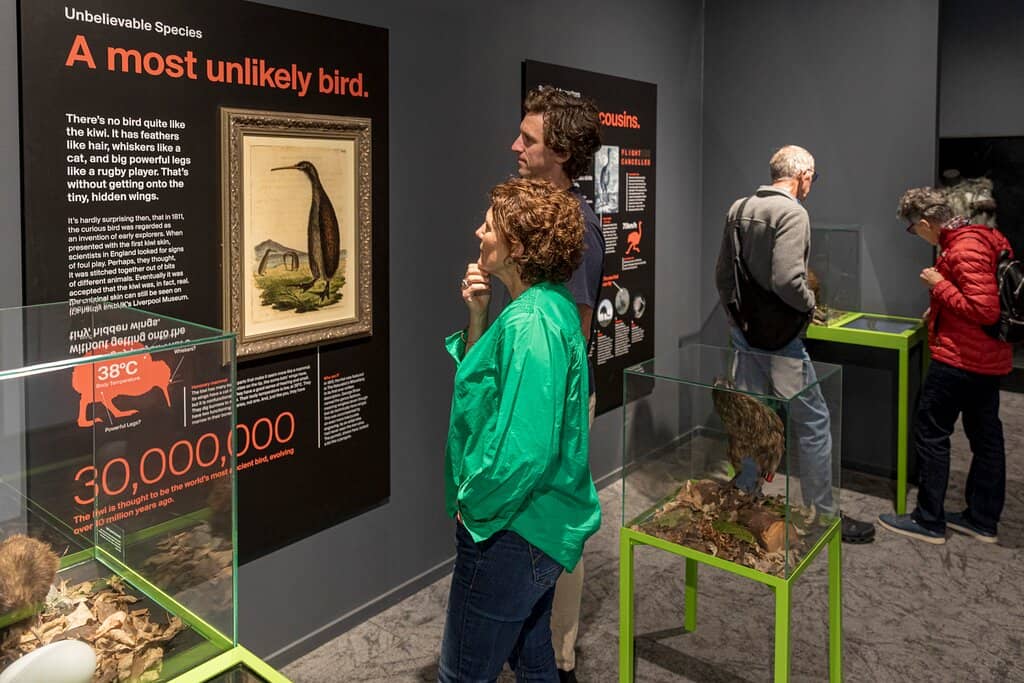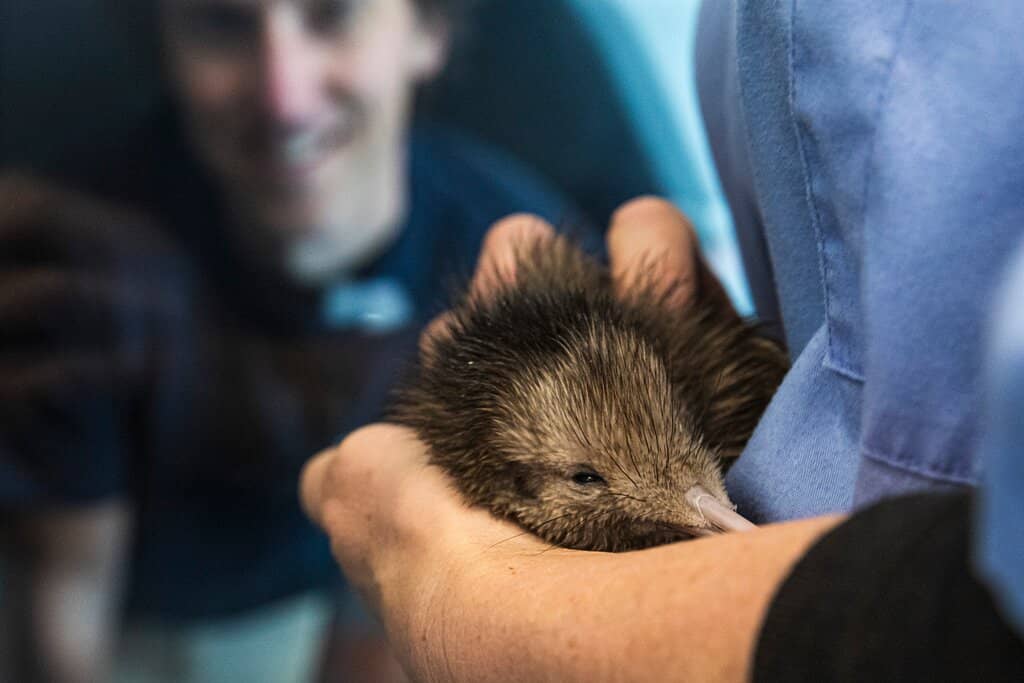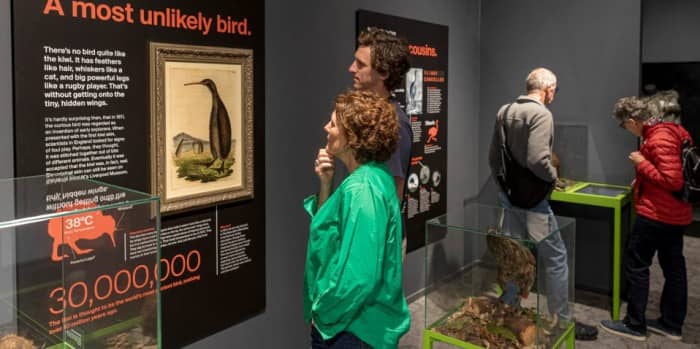
National Kiwi Hatchery
See New Zealand's shy, nocturnal kiwi bird up close and support vital conservation efforts at this unique hatchery.

Highlights
Must-see attractions

Social
From TikTok & Reddit
Best Time
Hatching season, more active birds

National Kiwi Hatchery
Best Time
Hatching season, more active birds

Highlights
Must-see attractions
See New Zealand's shy, nocturnal kiwi bird up close and support vital conservation efforts at this unique hatchery.
"A wonderful educational experience learning about fascinating kiwi birds!"

🎯 Book Hatching Season Tickets
Visit between Sep-Apr for hatching season! Expect crowds, but it's the best time to see eggs & chicks.
🤫 Be Quiet in the Dark Room
Kiwi are shy! Keep noise to a minimum in the dark viewing room for the best chance to see them.

Highlights
Discover the most iconic attractions and experiences

Nocturnal Kiwi Viewing
Dark Room
Witness the shy, nocturnal kiwi birds in their specially designed dark habitat. A truly unique opportunity to see New Zealand's national icon up close.

Incubator & Brooder Rooms
Incubator and Brooder Areas
See kiwi eggs in incubators and young chicks in brooders during hatching season. A heartwarming glimpse into the future of this endangered species.

Interactive Displays
Exhibition Area
Engage with informative displays about kiwi life cycles, predators, and conservation efforts. Fun for all ages, making learning about kiwis an adventure.
Plans like a pro.
Thinks like you
Planning Your Visit
Timing is Everything for Hatching Season
Support Conservation Efforts
Best Times
Insider Tips
from TikTok, Instagram & Reddit
Best place to see a kiwi?
🎯 Book Hatching Season Tickets
Visit between Sep-Apr for hatching season! Expect crowds, but it's the best time to see eggs & chicks.
🤫 Be Quiet in the Dark Room
Kiwi are shy! Keep noise to a minimum in the dark viewing room for the best chance to see them.
Critique My New Zealand North Island Trip?
💰 Support Conservation
Your ticket directly funds kiwi breeding & conservation. Feel good about your visit!
📸 No Photos in Dark Room
Photography is prohibited in the dark room to protect the kiwis' sensitive eyes.
Tips
from all over the internet
🎯 Book Hatching Season Tickets
Visit between Sep-Apr for hatching season! Expect crowds, but it's the best time to see eggs & chicks.
🤫 Be Quiet in the Dark Room
Kiwi are shy! Keep noise to a minimum in the dark viewing room for the best chance to see them.
💰 Support Conservation
Your ticket directly funds kiwi breeding & conservation. Feel good about your visit!
📸 No Photos in Dark Room
Photography is prohibited in the dark room to protect the kiwis' sensitive eyes.
🗣️ Ask the Guides
Staff are passionate & knowledgeable! Ask them questions; they love sharing insights.
What Travellers Say
Reviews Summary
Visitors consistently praise the National Kiwi Hatchery for its crucial conservation work and the unique opportunity to see kiwis. The passionate and knowledgeable guides are a major highlight, making the educational experience engaging for all ages. While the no-photography rule in the dark room is understandable, some wish for more opportunities to photograph the birds.
"Excellent conservation facility. Highly recommend visiting during hatching season. Incredible staff that answered my many questions with ease. Gorgeous (but shy) kiwi birds.
We were initially a little skeptical because of the location (seemingly within a super tourist farm experience), but the hatchery tickets fully support the kiwi breeding and conservation programs."
K J
"Very interactive displays and informative sharings! Our guide was really passionate and answered all our curious questions. It was really fun learning about the predators and matching the sounds. Bring more
money as the merchandise line up is incredible! I will definitely recommend this to my loved ones if they’re popping by Rotorua :)"
Yi-Nyn Lim
"We had a wonderful educational experience during our visit to the National Kiwi Hatchery. Teresa led a guided tour for our Odyssey Unlimited group. She did a fantastic job of sharing stories & explaining about these fascinating birds! We got to see a few which made the visit even more special Thank you!!"
Neil Armstrong
What People Like
What People Dislike
Frequently Asked Questions
🚇 🗺️ Getting There
The National Kiwi Hatchery is located in Rotorua, New Zealand. It's often part of a larger tourist farm experience. Many visitors arrive by car, as it's accessible by road. Public transport options might be limited, so checking local bus routes or considering a taxi/rideshare service from Rotorua's city center is advisable.
Yes, typically there is ample parking available for visitors, especially since it's often situated within a larger attraction. It's recommended to arrive a little early if you're visiting during peak hatching season to ensure a convenient spot.
Many Rotorua-based tours include a visit to the National Kiwi Hatchery or the surrounding tourist farm. This can be a convenient option if you prefer not to drive or want a guided experience. Check with local tour operators for package details.
Driving is the most straightforward method. Alternatively, local taxis or ride-sharing services can take you directly there. Some shuttle services might also be available, especially if you're staying in a Rotorua hotel.
While specific accessibility details should be confirmed directly with the hatchery, many modern visitor centers aim for good accessibility. Pathways are generally well-maintained, but the dark room viewing might require some navigation.
🎫 🎫 Tickets & Entry
Ticket prices vary, but a visit to the National Kiwi Hatchery directly supports conservation. Expect to pay an admission fee that contributes to the breeding and care of kiwi birds. It's best to check their official website for the most current pricing.
Booking in advance is highly recommended, especially if you plan to visit during the hatching season (September to April) or during school holidays. This ensures you secure your entry and avoid disappointment.
Opening hours can vary seasonally. Generally, the hatchery is open during daylight hours, but it's crucial to check their official website for the most up-to-date information on operating times before your visit.
Kiwi are nocturnal, so the best viewing is typically in the specially designed dark room. While the hatchery is open during the day, the most active viewing opportunities for kiwis are often during guided tours or in the evening if they offer special tours.
Discounts may be available for children, seniors, or family packages. Some local attractions or accommodation providers might offer bundled deals. It's worth inquiring directly or checking their website for any promotional offers.
🎫 🧭 Onsite Experience
You can see kiwi eggs in incubators, young chicks in brooders, and adult kiwis in a specially designed dark room. There are also interactive displays about kiwi conservation and their natural habitat.
Photography is strictly prohibited in the dark room where the kiwis are housed to protect their sensitive eyes. However, you may be able to take photos in other areas of the hatchery or the surrounding grounds.
Yes, guided tours are highly recommended. Knowledgeable guides share fascinating stories and information about the kiwi, making the experience much more enriching.
The best way to see a kiwi is in the dark room at the hatchery, where they are accustomed to the low light. Patience is key, as they can be quite shy and may be hiding.
Absolutely! The interactive displays and the chance to see a kiwi make it a fantastic experience for children. It's an educational and engaging outing for the whole family.
🍽️ 🍽️ Food & Dining
While the hatchery itself might have limited food services, it's often located within a larger tourist complex that usually offers cafes or restaurants. It's advisable to check the specific facilities available on-site or nearby.
Picnic areas might be available if you're visiting the broader tourist farm. However, check the specific rules regarding outside food within the hatchery's immediate visitor areas.
Being in Rotorua, you'll find a range of dining options from casual cafes to restaurants offering local cuisine. If the hatchery is part of a larger attraction, they will likely have their own food outlets.
This would depend on the specific cafe or restaurant operating at the hatchery or its associated attraction. It's best to check their menu online or inquire upon arrival for dietary options.
Prices at tourist attraction cafes can sometimes be higher than average. If budget is a concern, consider having a meal before or after your visit, or packing your own snacks.
📸 📸 Photography
Photography is strictly forbidden in the dark room where the kiwis are housed to protect their eyesight. In other areas, check for signage, but generally, photos of exhibits are allowed.
Since the main attraction (kiwis) is viewed in a dark room, daytime photography is limited. Focus on capturing the educational displays or the surrounding environment if permitted.
Absolutely not. Flash photography is prohibited in all areas where animals are present, especially in the sensitive dark room environment.
Yes, the interactive displays and information boards offer opportunities for educational photos. If the hatchery is part of a larger farm, there might be scenic spots for general photography.
Given the low-light conditions in the kiwi viewing area, a camera with good low-light performance or a tripod might be useful if photography were allowed. However, since it's not, a standard phone camera is sufficient for any permitted shots.
For Different Travelers
Tailored advice for your travel style
👨👩👧 Families with Kids
Pro-tip: Visit during hatching season (September to April) for the added excitement of seeing eggs and chicks. While photography isn't allowed in the kiwi viewing area, encourage your children to focus on observing and listening to the guides. It's a memorable and educational experience that instills an early appreciation for wildlife conservation.
🌿 Nature Enthusiasts & Conservationists
Focus on: Understanding the breeding programs, the challenges of predator control, and the success stories of kiwi reintroduction into predator-free sanctuaries. Your visit directly contributes to these vital initiatives, making it a meaningful way to support New Zealand's biodiversity.
📸 Photography Buffs (with a caveat)
Best approach: Focus on capturing the educational aspects and the story of kiwi conservation. Use your phone or camera to document the information presented, and rely on your memory and the experience itself for the kiwi viewing. Some visitors might find it a welcome break from constant picture-taking, allowing for deeper immersion.
Deep Dives
In-depth insights and expert knowledge
The Importance of Kiwi Conservation
The hatchery's work is vital for ensuring future generations can experience these fascinating creatures. The staff are passionate about their mission and are often eager to share detailed insights into the challenges and successes of kiwi conservation. Understanding the lifecycle, from egg to adult, and the threats they face makes the visit both educational and impactful.
By visiting the National Kiwi Hatchery, you are directly contributing to these conservation efforts. Your admission fee helps fund the incubation, rearing, and eventual release of kiwi chicks back into protected environments. It's a tangible way to support the preservation of a national treasure.
Experiencing Kiwi Viewing
During the hatching season (typically September to April), you might also have the opportunity to see kiwi eggs in incubators and young chicks in the brooder rooms. These stages of the kiwi's life are incredibly delicate, and the hatchery provides a safe and controlled environment for their development. Seeing a tiny chick is a truly special sight.
Remember that photography is strictly prohibited in the dark room to protect the kiwis' sensitive eyes. While this might be disappointing for some, it underscores the hatchery's commitment to the welfare of the birds. Focus on soaking in the unique experience and listening to the informative commentary from the guides.
The Role of Guides and Interactive Displays
Beyond the tours, interactive displays are designed to make learning fun and accessible for all ages. These exhibits often cover topics such as the kiwi's diet, its place in the ecosystem, and the challenges of predator control. Visitors can learn to identify kiwi calls and understand the different species of kiwi.
These elements combine to create a comprehensive understanding of the kiwi's importance to New Zealand's natural heritage. The enthusiasm of the staff and the engaging nature of the exhibits ensure that visitors leave with a deeper appreciation for these remarkable birds and the ongoing conservation efforts.





Social
from TikTok, Instagram & Reddit